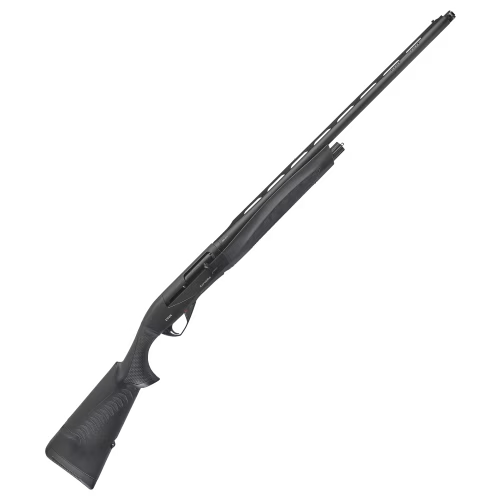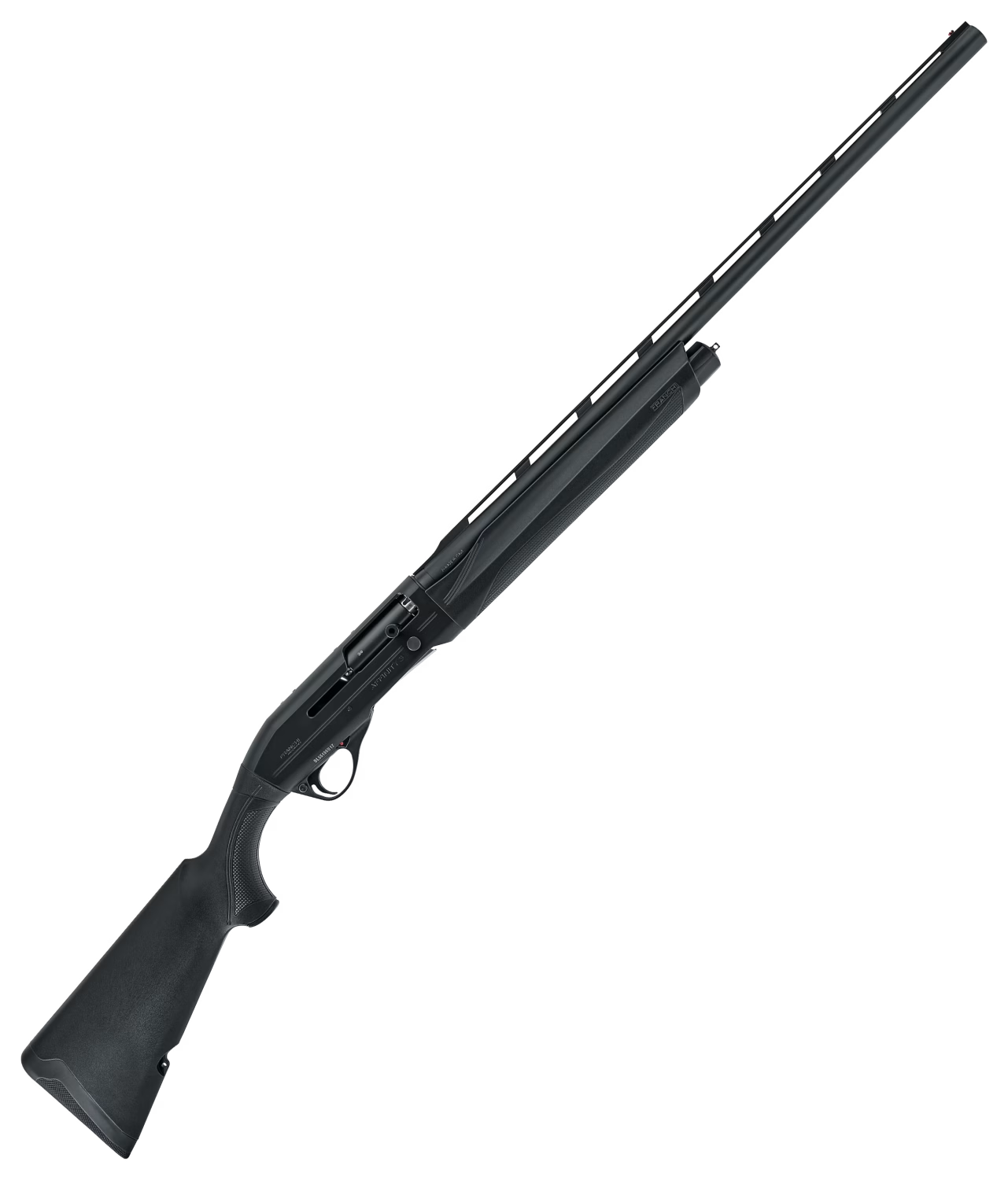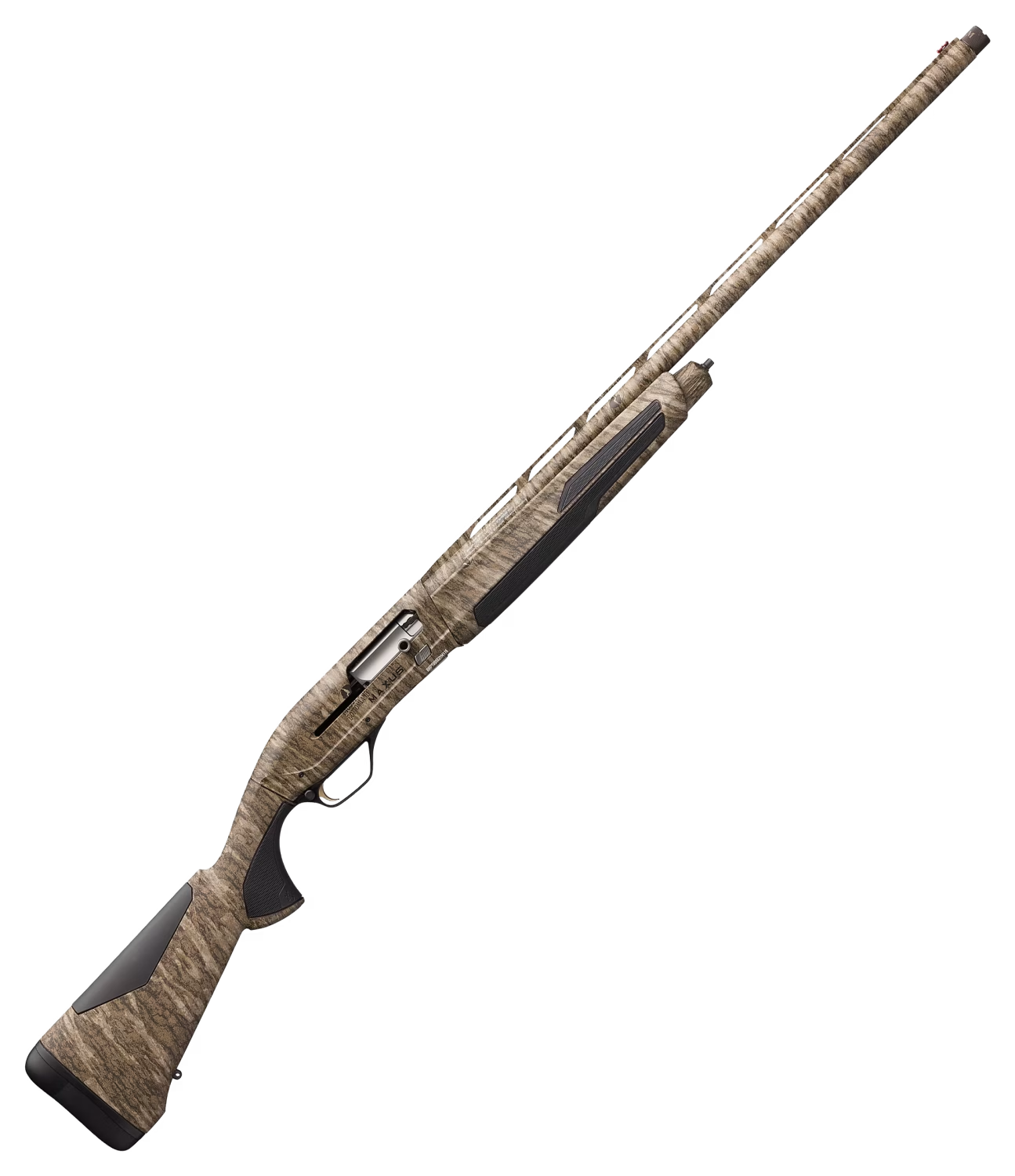Waterfowl shotguns have to work in the worst weather. They need to put heavy loads on target through rain, cold, ice, mud, dirt, and snow. They’ll take a beating, too, if you hunt in a pit blind, on rocky shores, or in soggy fields. While there’s a place for walnut and blued steel duck hunting shotguns, they require care and a bit of babying, which is totally fine if you’re into that. I am. Most waterfowlers want something that’s rugged enough to withstand the rigors of waterfowling, and that won’t shine in the blind to compromise their camo. Even I keep a black synthetic-stocked gun in the rotation for days when wood won’t fit in.

There’s more to waterfowl guns than exterior toughness. Mechanical reliability matters even more than a ding-resistant plastic stock. A gun that’s easy to operate and load even with cold fingers is a comfort on a raw day. Recoil reduction matters, and most important of all, no gun does you any good if you can’t shoot it straight. Here are some choices for some of the best new shotguns for waterfowl hunting of 2025 and some established favorites, too.
How we made our picks:
Toughness, reliability, recoil reduction, and ergonomics top the list of important qualities in a duck gun or a goose gun. Value matters, too, because some guns will be subject to so much abuse that it makes no sense to spend a lot on them in the first place. Balance and fit matter, too. Those are both subjective traits, and different guns fit different hunter’s shooting styles. I’ve had a chance to shoot most of these guns in the field as well as on the range, and I’ve evaluated them for the qualities that make them trusted companions in the duck blind.
Best Guns of 2025
Sorix

Key Features:
- Inertia operation
- 3- and 3 ½-inch 12 gauge and 3-inch 20-gauge chamberings
- Reversible bolt handle and safety for left-handed use
- Cerakote and hand-applied camo finish
Pros:
- Well-made Italian semiauto
- Attractive lines
- Easy reloads
- Hand-applied camo
Cons:
- Reversible charging handle is gimmicky
- Trigger is a little heavy
Weatherby’s newest shotgun is an Italian-made inertia gun that comes from the C.D. Europe factory, formerly known as Marocchi. I had a chance to shoot both the 12- and 20-gauge versions. I especially liked the ease of loading. Some inertia guns have stiff magazine springs and lifters that grab your finger. The Sorix does not, and the ease of loading helps make it a pleasure to shoot. The gun weighs about 7 pounds in 12-gauge, which is light enough to carry but heavy enough to shoot well. The trigger broke a little over 7 pounds on my test gun, which is on the heavy side but nothing I couldn’t live with. The camo finish is hand-applied at the factory in Sheridan, Wyoming and it gives the gun a distinctive look.
The gun has enlarged controls, including a big round safety button that reverses easily for left-hand use. The charging handle reverses, too, so left-handers can get that handle out of their vision when they shoot. Honestly, while I liked Soroix a lot, I am left-handed and saw no utility in switching the handle to the other side of the gun. In all, though, at $1499 the gun competes with other Italian inertia guns and the Browning A5 in price and offers an interesting alternative.
Ethos Cordoba BE.S.T AI

Key Features:
- Benelli BE.S.T. coating
- A.I. barrel contour
- Easy Locking Bolt
Pros:
- BE.S.T. coating works well
- Easy locking bolt prevents out-of-battery misfires
- A.I. improves velocity somewhat
- Overall good handling
- High-quality fit and finish
Cons:
- Expensive
- Higher point of impact
- Stiff to load
- Ported barrels not welcome in every blind
The Cordoba, with a host of Benelli’s high-tech features, is the most advanced semi-auto shotgun the company sells. Those advances are reflected in a $3500 price tag, too. Originally marketed as a gun for high-volume shooting, the Cordoba makes a fine waterfowl gun, especially due to the tough BE S.T. finish that protects it from corrosion and abrasion. The Advanced Impact (AI) is a tapered barrel boring system that almost literally squeezes a bit more velocity out of each shell thanks to the Venturi effect, and it has a new choke system to match it. Chronographing the gun with target loads compared to the same in an M2 showed a slight gain in velocity from the A.I.
I was surprised at how well I could shoot this gun. For whatever reason, it suited me very well. It’s a long, light gun with enough weight in the front end to be easy to shoot but still responsive. It did shoot high for me out of the box, but after I adjusted the fit with the included shims the gun shot much closer to where I looked when I mounted it. Benelli’s ComforTech stock does reduce recoil and vibration.
As a duck gun, or as an all-around field gun, the Ethos Cordoba is worth looking at if you have the money to spend on it.
EVENTIDE WATERFOWL

Key Features:
- 3 ½-inch 12-gauge
- Cerakote and camo finish
- Extractors
- Five choke tubes
Pros:
- Simple, reliable action
- 3 ½-inch chamber
- Weather-resistant
- Affordable
Cons:
- Extractors, not ejectors
Mossberg’s Silver Reserve guns have been around for almost 30 years, and have evolved into a reliable break action at a very good price. If you want the ultimate in reliability and don’t mind giving up a third shell, an O/U makes a great choice. The action is enclosed, and there’s very little to go wrong. O/Us are good guns for very bad conditions, and to make their O/U even more weatherproof, Mossberg adds a synthetic stock and Cerakote finish. The gun has sling-swivel studs, too, and its 3 ½-inch chamber means you can shoot any 12-gauge shell in your blind bag, including misshapen ammo that might hang up in a pump or semiauto.
The gun is 7 ¼-plus pounds, and while I’d prefer it to be heavier to absorb recoil, people like lighter guns these days. At around 6 pounds, the triggers are lighter than Silver Reserve triggers used to be. Extractors do slow reloading slightly, but adding ejectors also adds to the price, and Mossberg is able to sell the gun as is for $956. Likewise, the gun comes with flush chokes, not fancy extended tubes, but you are free to buy some for this gun. The Eventide, whether you accessorize it or not, is a gun to consider as a backup, a bad weather gun, or your primary waterfowl hunting gun if you like the idea of a break action.
Tried and True
Along with this year’s new guns, there are plenty of other good guns for waterfowl hunting on the market, too.
Affinity

Key Features
- Inertia operation
- 12 and 20-gauges available
- Affordably priced
- Light weight
Pros:
- Proven, reliable inertia operation
- Enlarged controls
- Good recoil pad
Cons:
- Lacks the Easy Locking bolt of Benellis
- Light weight inertia guns kick
The Franchi’s inertia guns are very similar to those sold by sister company Benelli, but without the high-tech features found on the more expensive Benellis. The Affinity’s large following among waterfowlers consists of those who would rather save hundreds of dollars on a gun at the expense of missing out on a few features. It does have a large bolt handle and slammer button and can be purchased in black, all-camo, or camo furniture with a Cerakote finish. There is also an Affinity 3.5 for magnum shells. It also comes in shortened “compact” versions in 20-gauge with 24- or 26-inch barrels.
The Affinity works, it points well, and it sells for $949, pricing it well below the comparable Benelli M2. The inertia system makes cleaning simple, and the gun’s oddly shaped TSA recoil pad does a good job of absorbing recoil, which can be stout in light, inertia-operated shotguns. The guns come with shim kits to adjust the fit. In all, it’s a good alternative if you don’t want to step all the way up to the Benelli.
Maxus

Key Features
- Stock made to be shortened easily
- Gas operation
- Conventional magazine cap
Pros
- Very soft recoil
- Easy loading
- Easy plug removal
Cons
- Only comes in 12-gauge
- Flagship guns sell at flagship prices

Browning’s flagship gas gun, the Maxus II, undoes the one annoying feature of the original and softens recoil even more. The original Maxus had an O/U-style forend latch that gave it a nice profile but was a chore to undo, a pain to put a sling on, and it was impossible to add an extension for spring snow geese. That problem was easily fixed with a switch to a simple, conventional threaded magazine cap.
The addition of a soft comb insert really helps with recoil. The old Maxus reduced recoil somewhat, but this gun is much more pleasant to shoot. I took one to an SCTP practice and let a number of kids shoot it and they all shot it well and complemented its lack of kick.
The gun comes in walnut or synthetic versions, with the synthetic featuring rubber inserts where a wood stock would have checkering. It has an enlarged bolt handle and a bolt release button that is big enough to use easily but not so big as to cause you to bump it accidentally. There is no crossbolt safety easier to switch to left-handed use than the Maxus II safety.
In addition to the soft comb insert, the stock has a long parallel section at the butt, which means you can shorten the stock and still use the original recoil pad. That pad, by the way, is Browning’s Inflex pad, which does a very good job of absorbing recoil. The simplest Maxus II, a 3-inch, black gun, lists for $1729, which is a lot, but you are also getting a lot of gun for your money. If you’re more of a fan of the traditional A5 style, check out our review HERE.
Super X4

Key Features
- Gas operation
- Available in 12 and 20 gauges
- Stock spacers for length adjustment
Pros
- Soft recoil
- Reliable
Cons
- Cheapened quality compared to SX3
Starting at $889 for a 3-inch 12-gauge in basic black, the SX4 makes a great choice in a gas-operated semiauto shotgun for hunters who don’t want to spend double that or more for a top-of-the-line Beretta or Browning gas semiauto. The SX4’s gas system does a great job of reducing felt recoil, and it’s easy to clean, too. The X4 can be made to fit a variety of people. The stock adjusts for length and for drop and cast, and the safety is easily reversible.
The SX4 is available in 3- and 3 ½-inch 12-gauge versions, as well as in 3-inch 20-gauge. It has enlarged controls, including a big, square safety button. The gun comes in several configurations appropriate to waterfowl hunting, including black, camo, camo, and Cerakote, and there are even true, mirror-image left-handed models.
835

Key Features
- Overbored barrel
- Thumb safety
- 3 ½-inch chamber
- Slide action
Pros:
- Smooth operation
- Ambidextrous safety
- Designed for 3 ½-inch shells
Cons:
- Stock not adjustable
- Inadequate recoil pad
Built from the beginning to be the first 3 ½-inch shotgun, the 835 has a 12-gauge barrel bored out to 10-gauge dimensions to better handle magnum loads of large shot. The result was a hard-hitting, durable pump gun that remains in production today. The extra-large bore of the 835 helps it pattern well, and the thumb safety makes it popular with left-handed shooters and those who shoot break-actions and want all their safeties to operate the same way.
The 835 is a hefty gun, closer to 8 pounds than to seven, but weight to help mitigate recoil is what you want in a pump designed for heavy loads. Of course, being a pump, the 835 can shoot any 2 ¾- or 3-inch shell, too, unlike some semiautos that can prove choosy about what they will and will not cycle. Mossberg has improved the 835 in recent years by getting rid of the barrel porting, which can make the gun unnecessarily loud in the blind, and by switching over to a new, easier-to-use safety button. The gun comes in full camo for waterfowling, and it makes a great choice for anyone who wants the simple reliability of a slide action.
A400 Xtreme

Key features
- Gas operated
- Available in 12- and 20-gauges
- Kick-off recoil reduction system available.
Pros:
- Gas system plus Kick-off makes this the softest-shooting semiauto around
- Very reliable
- Shoots a wide variety of ammunition
- Easy-off magazine cap
Cons
- Expensive
- Feels bulky to some
The A400 Xtreme is Beretta’s most advanced gas semi-auto. In its Xcel target version, it has found favor among sporting clays shooters, and it’s the only semi-auto gun you’ll see in serious sporting competition. The reliability and shootability that make the A400 popular in the target market cross over well to waterfowl hunting. With a 3 ½-inch chamber, durable camo finish, and Beretta’s rust-resistant Aqua Shield protection, the A400 makes the Xtreme Plus into a waterfowl gun that’s up to any type of duck or goose hunting. Synthetic stocked versions feature rubber grip inserts in place of checkering.
One neat feature of the gun is the mag cap, which you take off by depressing and then giving it a half-turn. It has a high visibility bright green plastic interior, too, so you can find it easily after dropping it in the water.
While the gun is heavier and bulkier than many waterfowl guns on the market, it’s a very easy gun to shoot well, in part because of that bulk and due to its low recoil as well. There is also a 20-gauge version. At $1949 the A400 Xtreme is not cheap, but it is the best.
All-Terrain Redhead

Key Features
- Cerakote finish
- Magnets in ejectors
- Extended chokes
Pros:
- Ejector magnets are more than a gimmick
- Tough finish
- Matte wood
Cons:
- 30-inch barrels no longer available
- Triggers can be heavy
The All-Terrain lineup comprises several CZ guns, including the Redhead O/U. Intended for waterfowlers, the All-Terrain guns feature matte walnut and olive-green Cerakote metal parts to help them blend in and resist corrosion. A convenient and clever feature of the break-action All-Terrain guns is the rare earth magnets in the ejectors. The magnets are strong enough to hold live shells in the chamber when the gun is tilted but aren’t so strong as to hinder ejection. The magnets make loading a break-action gun in a duck blind much easier and safer.
Underneath its O.D. Cerakote, the Redhead, is the same O/U CZ has offered for years. It’s a durable gun, a bit heavy at nearly 8 pounds, that sometimes suffers from heavy trigger pulls. That weight comes in handy when it’s time to swing on a long shot. Regrettably, the gun no longer comes with a 30-inch barrel option, which made it not only a smooth-swinging waterfowl gun but one that could crossover to targets as well. The Redhead comes in 3-inch 12- and 20-gauge models and is well worth a look for O/U fans.
Final Thoughts

A waterfowl gun needs to be a trusted companion, one that won’t let you down in bad weather or on days when chances are few. All the guns here meet the “trustworthy” criteria, but they all have different features, actions, and prices, and it’s up to you to think hard about what kinds of waterfowl hunting you do, what your budget might be, and then choose your gun wisely.

